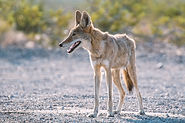Ringtail
Bassariscus astutus

Rarely seen but look for them at night near cliffs or campsites; sometimes spotted near human dwellings
The ringtail is a small, slender, nocturnal mammal native to Arizona, easily recognized by its long, bushy tail marked with alternating black and white rings. Highly agile and an excellent climber, ringtails can navigate rocky cliffs, trees, and canyon walls with ease. They are primarily nocturnal hunters, feeding on insects, small mammals, fruits, and berries, and are known for their clever and secretive behavior. Historically called a “miner’s cat,” ringtails were valued in mining camps for their ability to control rodent populations. Designated as Arizona’s official state mammal, ringtails are a unique and charismatic species that contribute to the ecological balance of desert, canyon, and woodland habitats.
Mammal

Identification & Behavior
Key Features: Large eyes for night vision, pointed face, long striped tail, excellent climber and jumper
Size: 2–3 lbs; body length 12–17 inches; tail 12–17 inches
Behavior: Solitary, highly territorial; den in rock crevices, hollow trees, or abandoned buildings
Diet: Omnivore — small mammals, birds, insects, lizards, fruits, and berries
Activity Pattern: Nocturnal
Habitat & Distribution
Found in southeastern and central Arizona, inhabiting forests, rocky canyons, and riparian corridors. Common in the Chiricahua, Huachuca, Santa Rita, and Pinaleno Mountains. Present in Coronado and Apache-Sitgreaves National Forests.
Elevation Range: Sea level to about 9,200 feet
Seasonal Presence: Year-round
Risks & Management
Shy and not dangerous to humans, but avoid feeding or cornering them









































